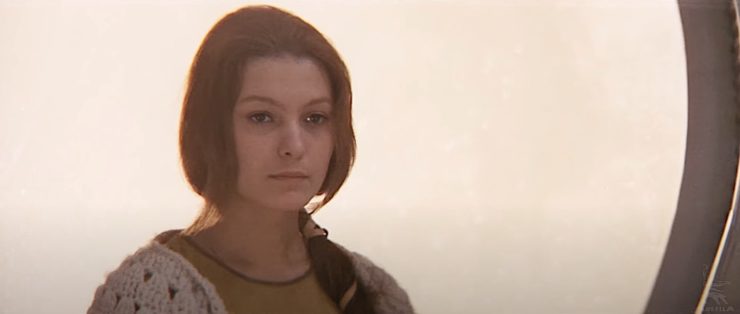Happy 50th anniversary to Solaris! And happy 20th anniversary to Solaris! Thanks to Tarkovsky’s version in 1972, and Steven Soderbergh’s in 2002, we all owe Solaris a set of fine china and something gold.
I’ve been thinking about what to say here. And. Look, it feels stupid to be writing about movies right now. Non-essential. But writing about this particular movie, a Russian classic about guilt, remorse, love conquering death, maybe, the desperate need for human connection in the face of teeming bureaucracy and political machinations and—
I’ve tried, is what I’m saying. I wasn’t sure how to talk about it, so I’ve ended up looking at this essay as a conversation between three films: Tarkovsky’s Solaris, Soderbergh’s Solaris, and, of course, Paul W. S. Anderson’s 1997 (Happy 25th anniversary! We owe you some silver!) cult classic space horror Event Horizon.
Let’s dive into the sentient ocean, shall we?
Andrei Tarkovsky was a Russian director, who, over the course of a thirty-year career, made seven films: Ivan’s Childhood (1962), Andrei Rublev (1966), Solaris (1972), Mirror (1975), Stalker (1979), Nostalghia (1983) and The Sacrifice (1986). He wrote a book about art, film, spirituality, and a whole lot of other stuff called Sculpting in Time, battled the Soviet Union’s cinema censors, and succeeded in that greatest of all accomplishments: becoming a meme. Of his films, 1972’s Solaris and 1979’s Stalker were overtly sci-fi. It’s also worth noting (because this is gonna come up) that Tarkovsky was super religious, and considered the making of art a religious act. As a person obsessed with the intersections between religion and media, surprise, I love Tarkovsky. (It helps to know that, at least if Andrei Rublov is any indication, Tarkovsky was also obsessed with the intersection between religion and media.)
We’ve celebrated Stalker a couple of times on this site. And before we go even a sentence further I need to share the funniest single thing I’ve ever seen: “Steamed Hams but it’s the film Stalker by Andrei Tarkovsky”.
To understand who we’re dealing with, here are a handful of quotes from Sculpting in Time and Andrei Tarkovsky: Interviews:
The allotted function of art is not, as is often assumed, to put across ideas, to propagate thoughts, to serve as example. The aim of art is to prepare a person for death, to plough and harrow his soul, rendering it capable of turning to good. (SiT, 43)
It is obvious that art cannot teach anyone anything, since in 4,000 years humanity has learnt nothing at all. (SiT, 50)
Masterpieces, not always distinguished or distinguishable among all the works with pretensions to genius, are scattered about the world like warning notices in a mine field. And it’s only by good luck that we’re not blown up! But that good luck generates a disbelief in the danger and allows the growth of fatuous pseudo-optimism. When that sort of optimistic world view is the order of the day, art becomes an irritant, like the mediaeval charlatan or alchemist. It seems dangerous because it is disturbing… (SiT, 54)
Man’s interest in a transcendent world has disappeared. Right not man is developing into a kind of earthworm: a tube that swallows up materials and leaves little piles of waste behind him. Don’t be surprised if one day the earth disappears because man has swallowed it all. (AT:I, 173)
So as you can see, he was rather HARDCORE.
But to get back to the film we’re celebrating today.
Solaris is a riff on first contact. In Stanislaw Lem’s novella, Earthlings discover a planet that is covered by an ocean, name it Solaris, and gradually figure out that ocean is sentient. They park a space station above it to study it, and the field of “Solaristics” is born. The trouble is that Solaris’ idea of communication is sending the living embodiment of the cosmonauts’ worst regrets up to the station. (Never get into a conversation with Solaris at a party. Yeesh.) Now, while Lem primarily wants to mock Soviet-style bureaucracy, and has fun with the sci-fi aspects of Solaristics, Tarkovsky saw Solaris as a way to think about memory, regret, and moral questions. (To be frank, you might not want to talk to Tarkovsky at a party either. I mean I would, but I’m a sucker for drunken party oversharing.)
In Tarkovsky’s adaptation, sad psychologist Kris Kelvin has been tasked with traveling to the station and assessing whether the field of Solaristics should continue. Kris seemingly lives with his father, with whom he has a strained relationship, and seems to be grieving, though we don’t know whether it’s for his deceased mother or someone else. A former cosmonaut, Burton, comes by the house with a warning that Things Are Not As They Seem, but Kris is unruffled. To give you an idea of Tarkovsky’s priorities: The film gives us lengthy, contemplative shots of lakes, fields, and Kris’ aunt’s horse.
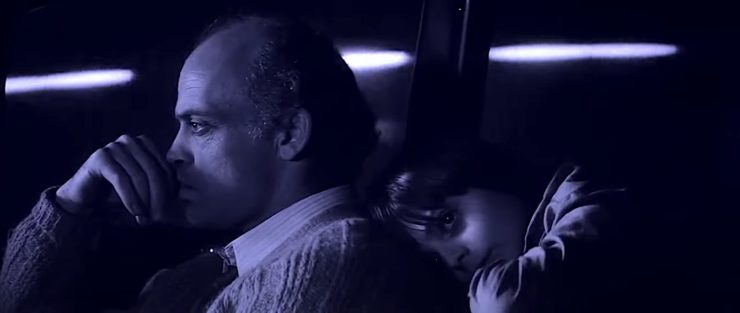
It also spends almost six minutes following Burton’s trip back to “The City”, which consists of him sitting in what seems to be a self-driving car and thinking really hard about What He Saw On Solaris. In contrast, Kris’ journey to Solaris only takes a few minutes of screen time, in which Kris faces the camera in his helmet, and then we see Solaris and the Station along with him.
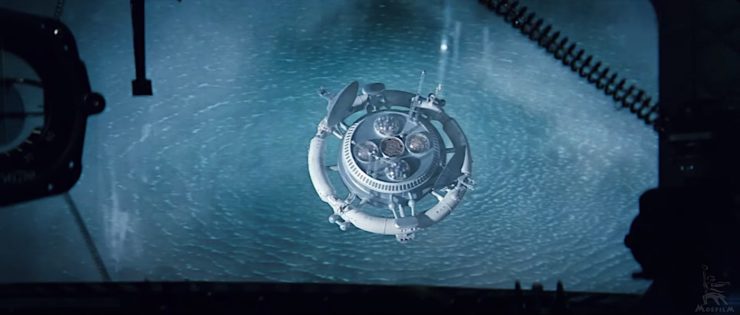
He might as well be taking a bus to space. Once at the station he attempts to talk with Dr. Sartorius and Dr. Snaut, who range from “cryptic” to “hostile”, and learns that their colleague, his old friend Dr. Gibarian, has committed suicide. Gibarian left him a video message (also cryptic) in which the doctor explains that Things Are Not As They Seem.
In the morning, Kris’ dead wife, Hari, is in the room. Except she’s not exactly Hari—it’s more like she’s a collection of Kris’ memories of Hari, that Solaris has harvested from his brain. At the outset she’s focused entirely on him, her love for him, and can’t be apart from him without utter screaming panic.
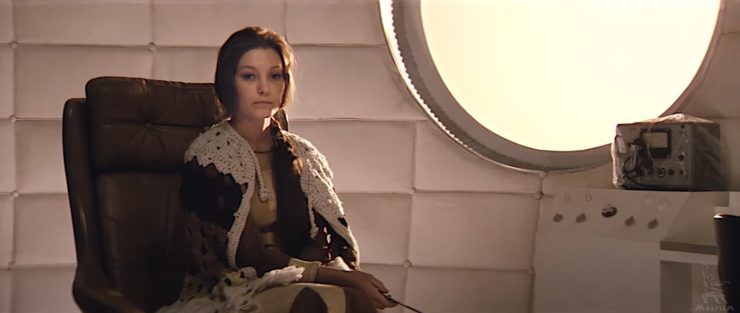
The rest of the movie unfolds very, very slowly as Kris confronts his guilt over his wife’s death, his grief for his mother, and whether any communication with Solaris is possible. Meanwhile, Hari seems to become more truly human (whatever the hell that means), a process hastened by her occasional violent deaths and resurrections. The three scientists respond quite differently to their Guests, with Snaut adopting a deadpan resignation, Sartorius finding their inhumanity offensive and trying to destroy them, and Kris falling into a full existential collapse.
The three genders.
Rather than focus on First Contact, life in space, or the huge question of whether Solaristics should continue as a field (the catalyst for Kris’ journey), the film’s through line becomes Kris’ grief and regret—about Hari and her suicide, his relationships with his parents, his alienation from nature, and, maybe, God (???). This theme weaves in and around Hari’s longing for connection, which sometimes focuses on Kris, sometimes on a life as a human on Earth, and sometimes, again, seems to drift Godwards.
***
But more on that in a bit, let’s check in on the crew of the Event Horizon! I’m sure everything’s going great.
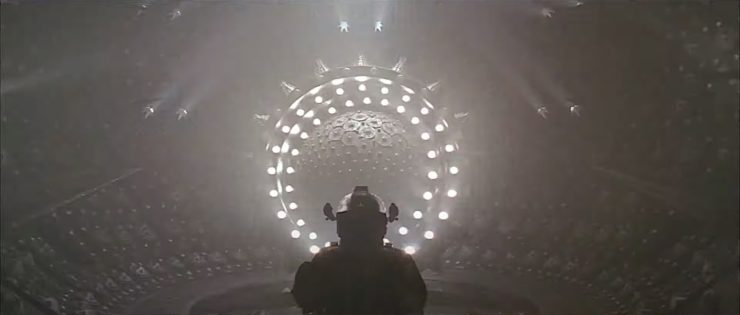
Event Horizon has some surprising connections to Tarkovsky’s work. It also plays with the idea of a powerful non-human being forcing a person to deal with guilt and remorse in space (and even features a terrifying corridor called “The Meat Grinder” in a seeming nod to Tarkovsky’s other SF masterpiece, Stalker) but here, no healing is possible.
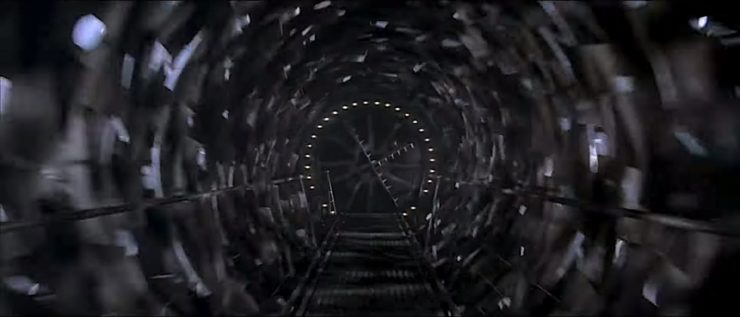
Dr. Billy Weir designed the Event Horizon using an experimental gravity drive that would theoretically allow the ship to circumvent FTL by creating its own wormhole, zipping through said wormhole, and popping out near Proxima Centauri. But the first time it used the drive, it vanished. When the crew of the Lewis and Clark, led by Captain Miller, are assigned to take Dr. Weir out to Neptune, they initially think it’s just a rescue mission to retrieve the Event Horizon, which seemingly made it back out of the wormhole.
However!
What actually happened is that the ship slipped through some sort of hell dimension, gained sentience, embraced EEE-VILLL, and is now intent on kidnapping the rescue crew and taking them back to hell. Along the way, it tortures the crew with visions of their regrets, in a brutal take on Solaris’ actions. Dr. Weir is forced to relive his wife’s suicide, which he believes was partly fueled by his abandonment of her. He sees her fully naked in the bathtub with a razor, then he’s kneeling on the bathroom floor, she comes up and embraces him. This moment of grief, remorse, and seeming forgiveness takes a very different turn. But when he looks up she says, “I have such wonderful, wonderful things to show you…” and opens her eyes, which are now BLOODY MADNESS PORTALS.

So, he has a psychotic break and gouges his eyes out with his fingers. (Later Weir runs with the Clive Barker reference by mutilating Jason Isaacs and hanging him from the ceiling in a clear homage to the “Jesus Wept” scene from Hellraiser.)
Meanwhile, a technician named Peters is guilty that she had to leave her young son because of this rescue mission. Which sucks, but it’s fine—it just means that he’s spending Christmas with his dad, and she’ll get summer when she gets home. It’s just a slight rearrangement of their usual divorced co-parenting routine. But the ship picks up on her nagging mom-guilt and torments her with visions of her son dying horrifically, and eventually lures her to her death with a phantom of the kid running through the ship. The camera pans up to show us the “boy” smirking at her body, even though the manifestation could just as easily disappear now that its work is done. We’re clearly meant to see that the ship enjoys torturing its victims.
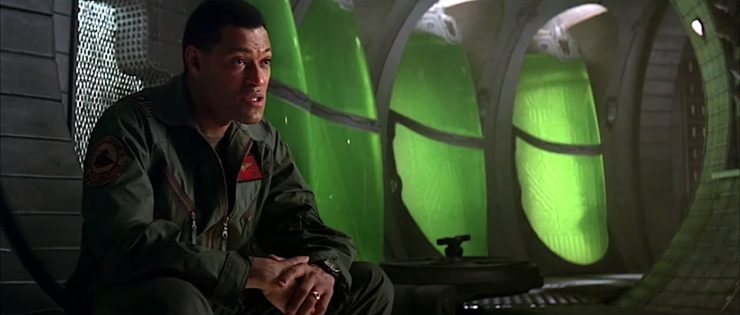
And what of Captain Miller? Well, here subtlety is entirely jettisoned into space. You see, many years ago, there was a terrible accident on Miller’s ship, and he had to make the choice of leaving one crew member behind to burn alive so everyone else could escape. This decision has haunted him, and, to be clear, Laurence Fishburne absolutely murders a scene where he muses on how beautiful fire is in zero gravity. (“Have you ever seen fire in zero gravity? It’s beautiful. it’s like liquid. It slides over everything. Comes up in waves.”)
Unfortunately, the Evil Sentient Ship can access all of his memories, and soon enough he’s faced with that lost crew member, engulfed in flame, screaming “YOU LET ME BURRRRRN!!!” and “YOU LEFT ME BEHIIIIIND!!!” directly into his face, until he, too, catches on fire.
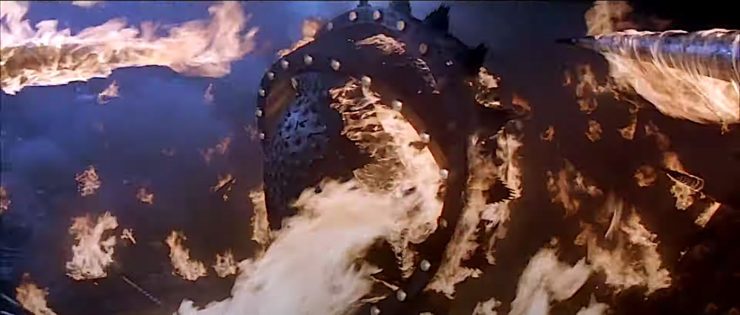
Event Horizon’s gruesome cavalcade of death has helped to make it a cult horror classic, but it also gives us a definitive answer to Solaris’ questions about Remorse! In! Spaaaace! There is no hope of learning, forgiveness, or redemption.
***
Soderbergh’s approach to these questions is a little more nuanced. His Solaris is quiet and mournful. From the opening scene we know that George Clooney’s character, Chris Kelvin, is grieving—the only question is whether he’s lost someone to death or a break-up. We’re joining a man living in a state of stasis. His apartment is minimalist and functional—no decorations or photos, no music playing. We quickly see that we’re in the future because he has the news playing on a screen that’s embedded in a glass wall, the trains are clean, and everyone dresses in clothes that are slightly exaggerated versions of what was popular in 2002. Also, in an overt nod to Tarkovsky, it’s always raining. Either grey, steady rain—Chris Kelvin’s grief externalized—or softer, romantic chill-hop rain in the amber-hued flashbacks of happier times with his wife, Rheya. Kelvin goes to the space station that hovers above Solaris because his old friend and colleague, Gibarian, explicitly requests him. And Gibarian explicitly requests him because he knows exactly what’s going to happen once Kelvin arrives at Solaris.
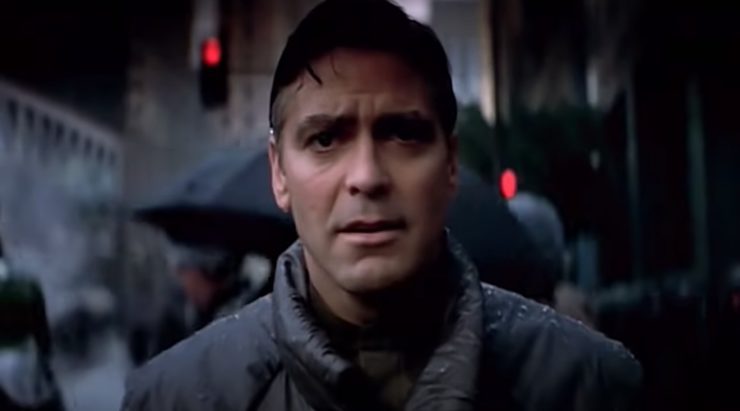
Chris heads to the station, learns that Gibarian has committed suicide, and meets Snaut and Sartorius’ counterparts, Dr. Snow (Jeremy Davies, my beloved, doing what I think is a slight Tarkovsky impression) and Dr. Gordon (Viola Davis, awesome as always). Inevitably Chris’ wife, Rheya, appears, and we soon learn (take a shot) that she committed suicide when she felt he abandoned her. Soderbergh puts even less emphasis on the sci-fi elements than Tarkovsky did—at first this is pure Sad Man In Space Times! But where it digs into something really interesting for me is when the movie begins to focus so much on Rheya’s experience that Chris fades into the background. (Or at least, as much as Clooney can fade into the background when a camera’s pointed at him.) Rheya can’t remember being Rheya, you see. She is a construct, made by Solaris, cobbled together from Chris’ memories of his late wife. When she remembers her life on Earth, it’s in relation to how Chris saw her. She’s depressed—but is that because of her status as a revenant? Or is it because Chris remembers her as a depressed person? When she remembers “her” suicide—is that how it really happened? Or is that Chris’ reconstruction of events, the panicked images his brain threw at him as he discovered Rheya’s body?
Like Tarkovsky, Soderberg takes Lem’s story as an opportunity to dive into God Stuff—but he does this far more through Rheya than Chris. It’s Rheya who is drawn to Solaris. She gazes at it from the station windows, explicitly calls it her creator, and longs to communicate with it, but has no idea how to do so. When we flash back to a time on Earth, we learn that the original Rheya was actually at least somewhat religious. But we learn this, of course, in relation to Chris: She halfheartedly tries to discuss the idea of a higher intelligence at a chic dinner party while Chris’ friends snicker, and Chris, rather than defend his partner, calls her beliefs childish.
This memory is another dent in her general impression of Chris, but it’s also an interesting window into how Soderberg works with the idea of “God”. It’s the subject of argument. Two people who are already having severe marital issues find themselves on opposite sides, and “God” becomes another excuse for an argument, for Chris to perform cool intellectualism for an audience, for him to win against Rheya, for Rheya to storm away and wallow in feeling misunderstood.
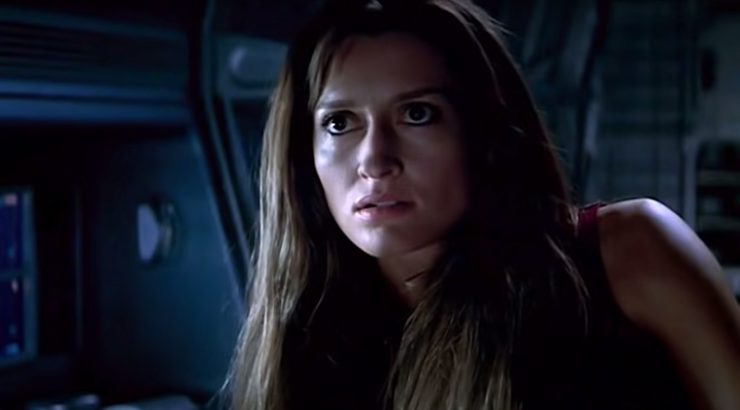
Once at Solaris, the planet’s sentient ocean becomes an active god. It’s creating the Visitors, but why? Rheya knows she came from the ocean, and feels an urge to communicate with the ocean, but she doesn’t know how, and it doesn’t give her any clues. But also—it’s reaching out to the people on the station, yes? It’s trying to communicate with them via the Visitors. Gibarian either saw this as a potential for healing (hence luring Kris to the station for his own good) or he thought it was a violation that was being inflicted on people (in that case, we can assume that he had a vendetta against Kris). Neither scenario explains why he chose to commit suicide—we’re just left with his Visitor, his toddler son, running around the ship like an innocent version of Peters’ kid from Event Horizon. We know that Rheya kills herself again because she can’t feel complete on the station, and life on Earth is impossible for her. We know because that’s what she tells Chris, and by extension us, in a video saying: “Maybe there’s a place where we could be happy, but it’s not on the station, and it’s not on Earth”.
A couple of plot twists later, Chris is back on Earth. But he can’t seem to adjust. He sleepwalks through one grey day after another, the rain never stops, and he can’t shake the depression. Was it a mistake to leave Solaris? And then he notices that there’s a picture of Rheya on his fridge, even though he’s in the apartment he moved into after her death, and he’s never hung a photo of her. And then he slips and cuts himself, and it seems to heal instantly. He snaps back to himself, still on the station in his suit, the escape pod waiting. He chooses to stay, knowing that the station is going to crash into the planet below.
Buy the Book


Sisters of the Forsaken Stars
As soon as Chris decides to let go and let Solaris have him, he’s joined by Gibarian’s Visitor, the small boy who looks like his son. He holds his hand and, seemingly, transports him back to his apartment, where Rheya appears and embraces him, telling him outright that they’re past all that when he asks if he’s dead or alive.
Did Solaris choose to send him a vision of his life back on Earth to give him another chance? Or was it luring him to his death? Did it do anything at all, or are these simply his own imaginings as the station crashes? We have no idea if Solaris has any opinions of him, or Rheya. Is it sending the Visitors as a chance at healing? Did Gibarian kill himself because he, too, was promised some sort of heaven?
And I think that’s an interesting outcome of Soderberg’s take. The audience is being prompted to respond to Solaris as a living entity with agency and opinions. Like Rheya, I want to know why it’s doing what it’s doing, and I want the astronauts to find a way to communicate with it. The movie seems to be encouraging us to want an active relationship with Solaris. Working in about half of Tarkovsky’s movie’s runtime, Soderberg opens with a somber, meditative movie, before pulling his audience through some drastic mood swings, shocks, and, as I mentioned, a couple startling plot twists, all to run us through a variety of emotions at increasing speed. Once we finally land back with Chris and Rheya together, I think the movie is reaching toward the idea that love has conquered all—but has it?
***
Which brings us back to cinema’s greatest Water Bender, Andrei Tarkovsky.

All of us travel through this world trailing ghosts in our wake. Past versions of ourselves, people we’ve wronged, people we’ve lost, versions of ourselves we might have been. While this is fertile psychic ground for any artist, that shit is catnip to an artist who is essentially religious, as Tarkovsky is. I don’t mean didactic work, but rather if you think of yourself as a person whose art is animated by your religious feelings, it can lead to an interesting space between what you want to express and the work itself. It’s that space that I love, and I love Tarkovsky, because he’s a person who was willing to talk (and talk and talk and TALK) about how his intense religious belief drove his work. And the fact that this is in conversation with a weird, kind of cold sci-fi movie, is just fantastic.
But in order to talk about the movie’s greatest scene, we must, like the philosophers Violent J and Shaggy 2 Dope, attempt to define the miraculous.
Tarkovsky’s approach to Solaris is to focus almost entirely on Kris Kelvin’s perspective and feelings of remorse… until he abruptly shifts to Hari. Hari is at first an object. She is a memory of Kris’ past, a symbol of his guilt, a ghost haunting him. His first reaction is to push her into a shuttle and send her away—but unlike Soderberg, Tarkovsky doesn’t show us Hari’s terror, only Kris’ horror at his own actions. When Hari reappears, she is still framed far more as the site of Kris’ grief than as a person, because, as Dr. Sartorius insists, she’s not a person. She’s a synthetic creation of Solaris, and Kris’ attempts to create a relationship with her are unnatural and disgusting.
But Tarkovsky doesn’t seem to agree with Sartorius. As the film continues on its slow path, Hari begins to feel her own emotions apart from her love of Kris. When Kris brings her to a birthday party for Snaut, she attempts to drink water (she appears to choke on it) and refers to herself as a lady. When Sartorius blows up at her again and she begins crying, Kris falls to his knees at her feet, grabs her hand, buries he face in her thighs. Unlike Event Horizon’s horrific mirror of this scene, Tarkovsky’s aim, I think, is to create a space for Kris’ remorse, and the potential for forgiveness.
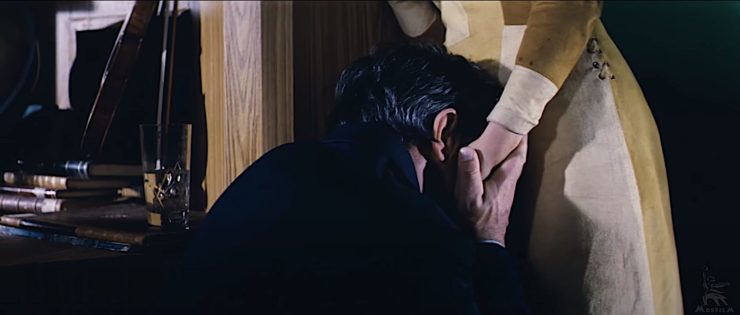
He sits with the couple for a moment before Sartorius explodes again, screaming at Kris to get to his feet. The doctor is disgusted by the sight of a human humbling himself before an alien being, Kris ignores him for a moment—we think he has chosen Hari, whatever the cost. (Again, this is Tarkovsky, and it’s specifically Tarkovsky dancing around Soviet censors, so it’s impossible for me to read this scene without seeing Hari as an avatar for the god that is Solaris, and Kris as a man, like Tarkovsky’s later Stalker, who chooses a spiritual path in the face of a materialist society. This reading is only strengthened by Hari’s habit of dying and resurrecting.) But then Kris does get up, his head drooping. Is this a rejection of Hari, or was his remorse enough? Or is everything more complicated than that?
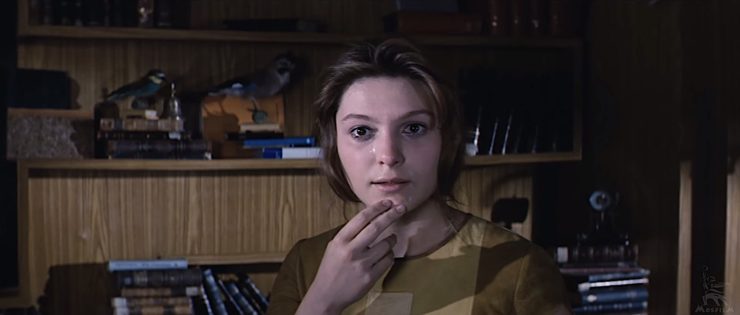
A few moments later, Snaut reminds Kris that the gravity will be shut off at 5:00am. A few moments after that we get the transcendentally beautiful sequence of Hari losing herself in Breughel’s The Hunters in the Snow, looking into the painting with such focus that the scenes of a Russian winter come to life. It’s in this moment that she becomes fully “human,” whatever that means. Human-ness in this case seems to have something to do with being willing to be still and calm, contemplating an image, and allowing yourself to feel something. Hari transports herself into the painting, as Tarkovsky gives us multiple close-ups of the action of the painting (a scene of a winter in Russia: Men hunt with a pack of dogs; children skate and play games on a frozen lake; adults go about their regular lives in a snowy rural town) intercut with Hari communing with the painting and crying. It’s kind of like we’re watching her watch her first movie.
And, then, when Kris comes back to her and embraces her again, the gravity drops off. The two float in the air together, clinging to each other, Kris wracked with emotion, Hari, seemingly calm.
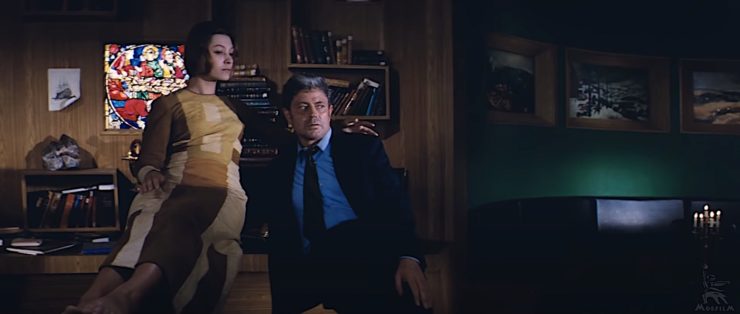
Did Tarkovsky find a purely scientific way to allow his character to fly? Yes. Does it feel kind of miraculous anyway, given all the tiny choices and details that have led up to it? Also yes. Whatever else happens in the movie (and a lot happens) Tarkovsky is using the story to show us that a certain kind of healing is possible if you choose to reckon with your past. Faced with the question of reckoning with your past, Soderberg’s film reunited Chris and Rheya in a fuzzy afterlife, and Anderson’s made the bold choice that facing your past mistakes = LITERAL HELL. But Tarkovsky took this question and gave us a moment of reconciliation. Is it difficult and kinda harrowing? Yes! Does it also offer us a vision of two people transcending their terrible history and loving each other as they are? Also, yes!
One of the reasons this works so beautifully is precisely because of Tarkovsky’s approach to science fiction. Interviewed about sci-fi as a genre, he talked about how he wanted to push back against sci-fi in general and 2001: A Space Odyssey in particular:
For example, if one shoots a scene of passengers boarding a trolley, which, let’s say, we’d never seen or known anything about, then we’d get something like Kubrick’s moon-landing scene. On the other hand, if one were to shoot the moon landing like a common trolley stop in a modern film, then everything would be as it should. That means to create psychologically, not an exotic but a real, everyday environment that would be conveyed to the viewer through the perception of the film’s characters. That’s why a detailed examination of the technological processes of the future transforms the emotional foundation of a film, as a work of art, into a lifeless schema with only pretensions to the truth.
When Tarkovsky shows us Snaut reminding Kris that the gravity’s going to be turned off, it’s a casual moment, like “don’t forget we need to pick some bread and coffee up at the store”, so when the gravity drops out, and Hari and Kris rise into the air, we know that this is a scientific miracle. But somehow, in addition to satisfying Soviet censors, it feels even more extraordinary, first I think because by giving the reminder as an offhand statement Tarkovsky buries the significance, but more so because life in space has been treated as banal up to this scene. We don’t get long, Kubrickian shots of the wonders of technology, or ships spinning against the void of space—the station might as well be an IKEA. And then, even more, it feels, to me at least, like a reward for Kris’ attempt at putting his love for Hari above everything else, and for Hari’s increasing empathy for humanity. It’s a reprieve from the terrible trap they’re in. And I think it’s also important that Solaris has nothing to do with it.
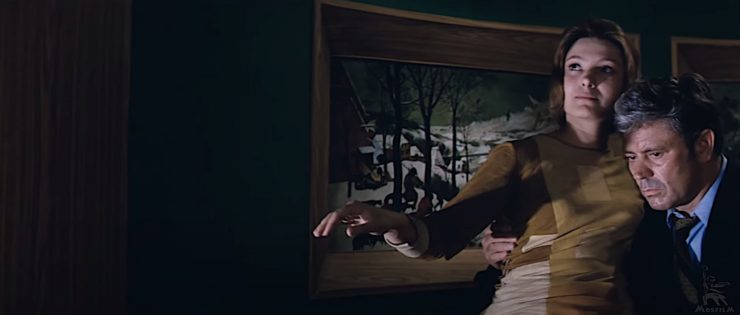
But of course the most important thing of all is that this reprieve is brief.
This isn’t the somewhat gloopy “love conquers all” feeling of Soderberg’s version, or the fiery nihilism of Anderson’s. There are no easy victories to be had, but the moments of joy are worth all the more because of that.
***
Which leads me to the last thing, which is just that the film itself, like I think most of Tarkovsky’s films, is an ikon.
In Andrei Rublev (this one, not this one) Tarkovsky tells the story of Russia’s greatest ikon painter. He shows him as a particular type of artist at work—one who isn’t really allowed to have an ego, who has to work within a religious establishment as well as under a system of patronage, and who doesn’t even receive credit for his work in most instances, let alone fortune or glory. When Tarkovsky talks about the film it’s kind of easy to apply everything he’s saying to the films he made after Rublev.
The image in an ikon painting has a purely interior meaning and symbolism, by no means external or figurative. It’s pure metaphysics. An icon was not a depiction of the divine, nor its material manifestation. This is very important, because the best works by Medieval Russian ikon painters are essentially embodied meditations on the Absolute.
I think it’s safe to say that beginning with Solaris, Tarkovsky increasingly works toward creating a cinema of ikons.

Tarkovsky’s Solaris becomes an ikon to be contemplated. He doesn’t manufacture drama between the characters, or throw plot twists in for one last shock before the credits. He allows all the tension to come from different personalities scraping against each other. He neither runs from guilt, not wallows in it—it’s just another thing to be processed. And while the characters do tend to muse at length, he doesn’t use any of them as mouthpieces for a particular philosophy. Kris and Hari have each made terrible, un-take-back-able decisions. Tarkovsky gives them time to think, and feel, onscreen. And then there are moments like the end of the levitation scene, where the audience is asked to sit with what they’ve just seen in a long static shot. If you’re not in the right mood for it this could make you uncomfortable, or even seem laughable—but he’s trying to use the language of film, and specifically in this instance the language of SF, to tell a different kind of story.
He’s not worrying about handholding us through his characters emotions, or throwing twists at us to make sure we’re still awake. He’s not giving us sci-fi full of laser sword battles or humans being hunted by evil AI. He’s using sci-fi to take us away from the comfort zone of Earth, and show us that our wounds will follow us into space. He uses tech not to celebrate human progress, but to ask deep questions about what actually makes us human. He takes the basic idea of a ghost story and focuses on the idea that ghosts can only hold power over us if we love our dead. He uses film itself as an ikon—not in service to any particular religious sect, but as a still moment in space and time for the viewer to sit with their own unique ghosts.
I like to think we can tell a different kind of story.
Just to think of a couple of recent examples: Blade Runner 2049 asked knotty questions about personhood and consciousness, but punctuated those questions with drawn-out scenes of replicants kicking the crap out of each other—moments designed to make the audience feel the visceral rush of adrenaline at seeing physical violence. Ex Machina asked knotty questions about personhood and consciousness, but made sure to take time for some fight scenes—designed to make the audience feel a visceral rush of adrenaline. Event Horizon is a horror movie, sure, but there are more ways to do horror than to show us people being physically tortured. Even Soderberg felt the need to cram a plot twist into the last half hour of his Solaris—what had been a fairly contemplative film.
I’ve been thinking about personhood a lot lately—I mean, I always have, but even more since about 2015, for all the social justice-based reasons you might expect. I’ve been clocking that when a particularly bad actors inflict horror on others I have a tendency to call them monsters, or, in one case, to refuse to say their name entirely. I am, from a certain point of view, revoking their personhood. Florida and Texas, the two places I spent my youth, are trying to revoke personhood, but those fuckers don’t get to do that, not to me, and not to anyone else—but that’s just the point. I don’t get to do it either. Just because it’s retaliatory, that doesn’t suddenly grant me the Personhood Stick. The bad actors are as human as me, as human as the people fighting for their land, for their freedom, for their right to exist the same way in Longview or Orlando as they would in New York. Their choice to deny humanity shouldn’t dictate that I do the same.
And I think the reason I’ve been thinking about Tarkovsky so much is because he is such a stark corrective to all these other films, and, hell, to the stories the world is choosing to tell at the moment. By taking a sci-fi story and making it about the idea of consciousness and personhood, and making it intense, gripping, moving, he shows us what the genre can accomplish when you refuse to fall back on “now they must punch each other” or “the AI is evil for some reason and will surely kill us”. By using the film as an ikon he’s inviting us—or maybe I should say trusting us—to recognize the personhood of his characters. He’s asking us to look at Hari as she looks at the people in the Brueghel painting, to sit with her image as we would sit with an ikon, and to think real hard about what makes us human.
Or to use Tarkovsky’s own words: “Maybe, indeed, Kelvin’s mission on Solaris has only one aim: to show that love of the other is indispensable to all life. A man without love is no longer a man. The entire ‘solaristic’ is meant to show that humanity must be love.”
Leah Schnelbach will absolutely shoot their shot with Solaris if they ever bump into each other at a party. Come join them in the haunted space station that is Twitter!










